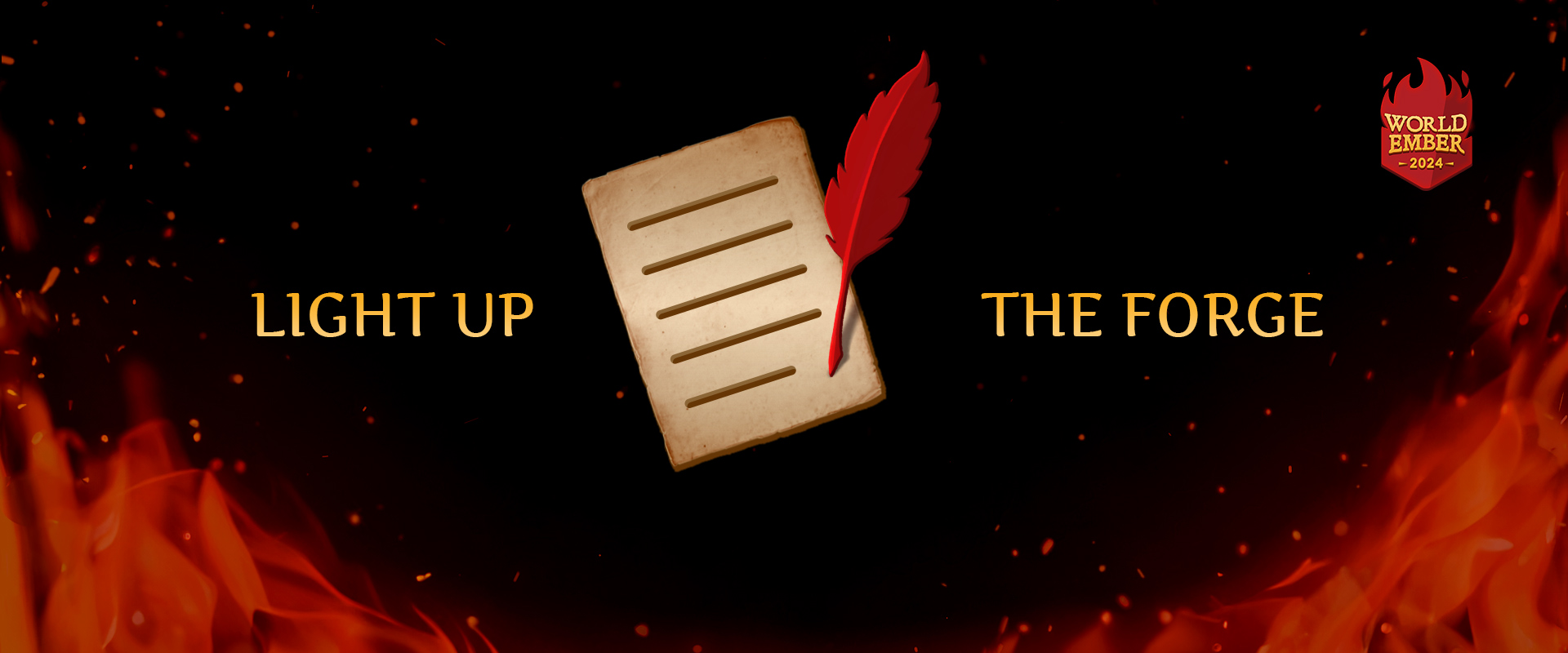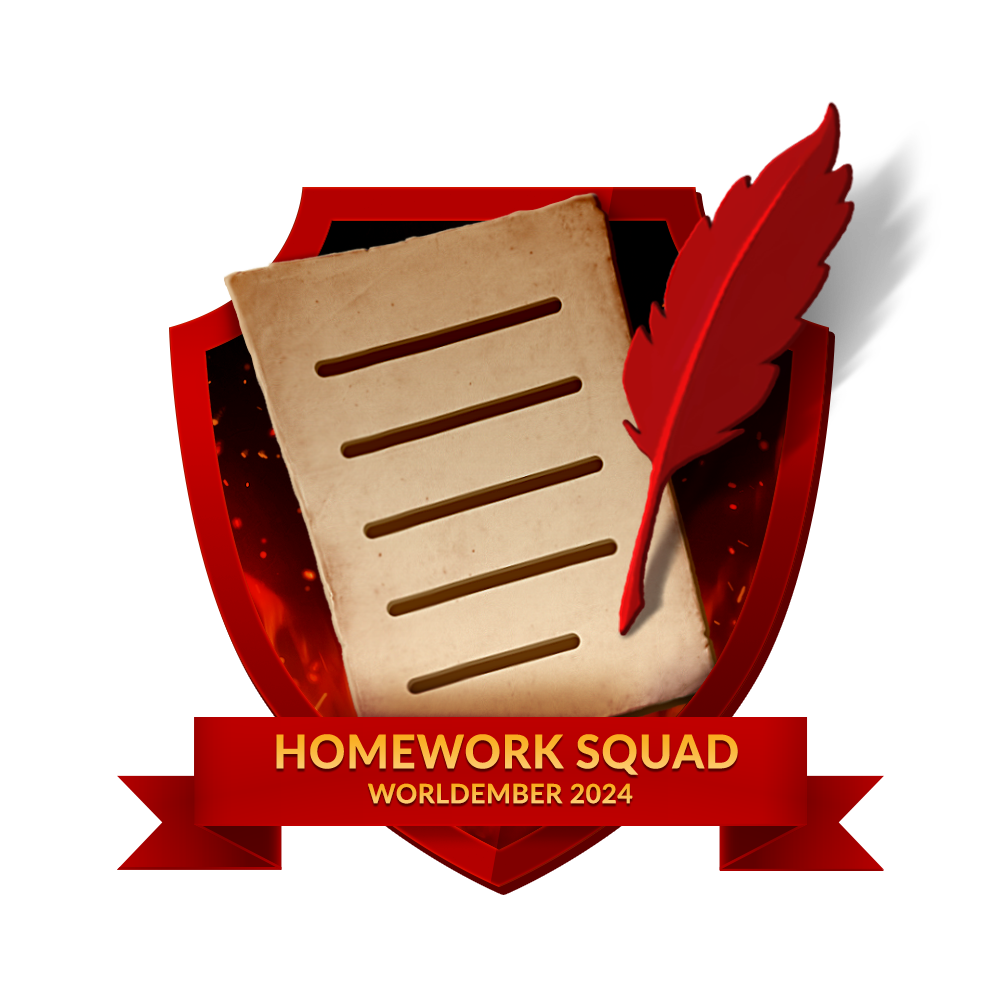WorldEmber Prep 2024
Remove these ads. Join the Worldbuilders Guild

WorldEmber Prep 2024
Get ready for the biggest worldbuilding event of the year!
WorldEmber is (almost) here! In December you'll be challenged to write 10,000 words of original worldbuilding—but first, it's time to prepare! To get ready for WorldEmber (and snag yourself the Homework Squad badge), submit your weekly homework assignments (you'll find the option on the right while editing your article). We'll update this page every week with a new assignment!
But wait... what's WorldEmber?
WorldEmber is the largest worldbuilding event of the year! During December, we challenge you to write at least 10,000 words of original worldbuilding about any topic—doing so will earn you a virtual badge and a chance to win prizes in the raffle.
You can also aim higher for the 25k or even 50k wordcount badges. And of course, if you're feeling competitive, you can submit to special categories to be judged—if you win, you get a prize! However your year has gone, WorldEmber is a great way to end the year with a super achievement under your belt!
Weekly assignments
This section will be updated weekly to include the newest homework assignment. These are the reveal dates:- First assignment: November 1st
- Second assignment: November 8th
- Third assignment: November 15th
- Fourth assignment: November 22nd
- WorldEmber launch: November 30th
Week 1: Pledge Your Goal
The first step when preparing for a challenge like WorldEmber is to set a goal. After all, working towards a specific goal tends to be way more motivating than just writing aimlessly!1. Set a word goal and your area of focus
How much do you want to write this month? The goal of WorldEmber is 10,000 words, but you can decide to aim higher if you feel up to the challenge! Download this pdf to pledge your goal:2. Choose your area of focus
You know how much you'll write—now's time to decide what you'll write about! Look at your world, and pick your area of focus. Here are some examples!- Fauna and flora in your world
- Magic systems, items, and factions
- The traditions and history of a culture
- Expand on the worldbuilding from your NovelEmber project
- The setting of your upcoming campaign
- What are you excited about? If you feel excited about an area of your worldbuilding, follow your instincts! It’s easier to keep your motivation up if you write about a topic you enjoy.
- If you have an ongoing or planned story (novel or campaign), pick something that will be useful for it. This will give your worldbuilding a sense of purpose, motivating you throughout the challenge. Otherwise, make a list of directions you could go in. Look at your world map, read your meta document or world primer, and find an area that seems interesting to you.
- Or how about creating a whole new world? Starting from scratch means you can write about basically anything, which is great for a wordcount-based challenge like WorldEmber.
3. Create or update your meta
The meta document is all the information about your world that isn't part of the world. It will help you stay on track, keep you motivated, and will prevent inconsistencies in your worldbuilding. If you're starting a new world, create your meta now! And if you're writing in an existing world, review your meta and consider creating a specific mini-meta for the area you'll explore during this month. Here are a couple of resources to help you out: To submit the homework, create a Generic Article with the pledge document and explain what your area of focus will be!Week 2: Prepare Your World for New Readers
WorldEmber is a great moment to get new readers to your world, as you'll be writing a lot of new content (and probably sharing it too)! So let's take a week make sure your world is ready for new readers!1. Review your homepage
The homepage is what most readers will see when they first open your world. So take a look at it now—make sure that it...- ...has a clear but short explanation of what your world is about (aka an elevator pitch).
- ...sets the proper expectations for your readers (should they expect fun dino-taming adventures, or Cthulhu-style cosmic horror mysteries?)
- ...includes a clear user journey. Or, in other words, tells your reader what they should read next so they don't get overwhelmed by all your content.
- ...is easy to look at! First impressions are important, so double-check that everything is readable, without long paragraphs.
2. Create or review your world primer
Also known as an introduction article, this is a page that has all the fundamental information your readers need to know about the world. Unlike the homepage, it's not about hooking your readers, but about teaching them all the basic concepts. Depending on the type of world you're writing, it could include:- The most important factions or characters: who will your readers meet?
- Information on the magic system and technological level: is this well-known or kept as a mystery?
- Relevant differences compared to the real world: are there floating islands? Differences in gravity?
- What the current conflicts are—conflict is super important to make stories interesting!
3. Set up your community tools
World Anvil has a bunch of tools to create a community around your world! Here are some ideas:- Add a follow button to the most important articles. As a Guild member, you can also add them to a global content field so they appear in all articles!
- Set up self-assigned subscriber groups (Guild-only). Some Anvilites use them to show additional content (such as spoilers), while others use them to present different perspectives on the same content.
- Add links to your worldbuilding-related projects! Have you written a book or run a creative livestreams related to worldbuilding? Or maybe you have your own Discord server for your world? Add links to the world so your readers can find your stuff easily!
4. CSS wizardry
If you're a CSS wizard, it's time to cast your spell! CSS will only be a distraction in December, so now's a good time to do some spring cleaning and tweak the visual style of your world! Check that the style reflects the tone and mood of your world, and that everything is readable and has good contrast. To submit this week's homework, update the article you submitted for week 1, adding how you approached these week 2 tasks!Week 3: On the Hunt for Inspiration!
Finding the perfect inspiration for what you want to write can take some time—and time is super valuable during a challenge like WorldEmber! So, this week, let's focus on finding sources of inspiration for your world. Then, during WorldEmber, you can go back to them any time you feel stuck!1. Read a book or watch a movie!
Choose a story that has something in common with your world—it could be the genre, the tone, a similar main character, or anything else. The point is to experience a similar story so you can see what other authors are doing with the same tools! Write down what made you enjoy it (or not enjoy it!) and what ideas it inspires.2. Create a moodboard
Moodboards are a great way to get immersed in a specific mood, by picking images and music and putting them on a single page. To do so, take a look at your meta to remember the tone and mood you were going for, and then jump on sites like Pinterest or ArtStation to find images that reflect that! You can also use your own art or pictures. If you're using other people's art for your moodboard, remember to keep it private unless you have the artist's permission to use it! Then, either share it in your homework article or write about your process for building the moodboard.3. Create or expand your writing playlist
If you prefer to listen to music while writing, now's the time to prepare the playlist! Otherwise, you'll lose precious time in December going through different music styles until you find the right one. Choose music that fits your music taste, and try to make it fit the mood you're going for. After all, writing a dark mystery setting is much easier if you're listening to some moody music instead of Vivaldi's Spring! Use your preferred music listening software to create a writing playlist that's long enough to cover your writing sessions. Then, either share it in your homework article or explain your choices in writing! Add your answer to this week's assignment to your homework article!Week 4: Harness the Power of Friendship!
Few things help more in WorldEmber than a group of worldbuilder friends cheering you on and exchanging ideas with you! Use this last week of prep to find some friends you can lean on during the upcoming month.1. Find a community
The internet is full of creative communities for worldbuilders, writers, and Game Masters! If you prefer real-life friendships, a friend will work too. Whatever the case, let people know what your goal for WorldEmber is! You can even share your WorldEmber work with them during December—for some people, having other people read their work is really motivating. If you want to join an online community but can't find one, join our Discord server! Or, if you prefer, check out our Facebook group and Reddit community too! Use the #WEPrep hashtag on social media to join the conversation there.2. Plan your writing schedule
Be it school, work, or family, most people have busy schedules! So look at your calendar and think about when you'll have time to write. Then, make sure those hours are sacred! If you have family obligations, try to deal with them in advance and tell everyone at home to not bother you during your writing time. If you go to school or have a job, make good use of your free days or breaks. Planning in advance means that, as soon as you get to your writing times, nothing else will get in your way!3. Get some fresh air!
It's been a month of hard work to prepare your world (and yourself!) for December... but the next month is the real challenge! Just like you would rest the night before a marathon, take some days to breathe and rest before WorldEmber. Go out for a walk, meet up with friends, and relax so your brain is ready for December. Write in your homework article about how you prepared this week. Don't forget to submit your homework to get the participation badge!Challenge entries
Hell
by Forever596





